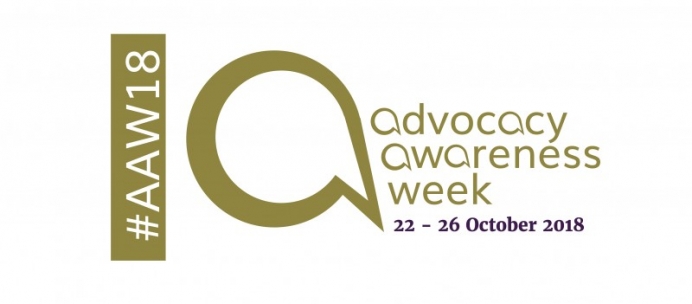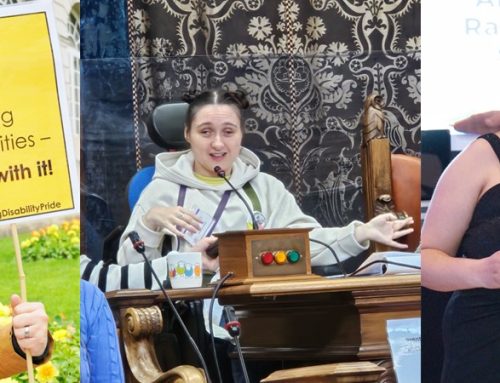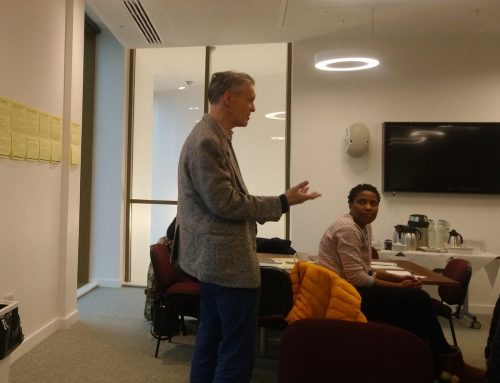Advocacy Awareness Week 2018: “Voice” – Building Identity and Self-Expression
By Gill Loomes, Leeds Autism AIM Peer Development Worker
Welcome to Part 3 in this mini-series for Advocacy Awareness Week 2018, called “Finding Our Voice”, where we are thinking about how we can explain advocacy, and raise awareness of the work we do. In the previous two parts of the series, we have begun to think about the concept of social “Voice”, as a central element of advocacy. We established that “Voice” is a bridge between the individual and the world around us.
In this part, we explore the first two of five key themes that form this bridge. These two themes focus particularly on the importance of “Voice” for the individual – for how we understand ourselves, and make our mark on the world. We begin by thinking about identity.
Identity-Building
When we construct our identity, we draw on, and mould the “voices” we hear around us, in order to form our own “voice” with which we make our mark on the world. Bagatell (2007) explains in detail how this process can work in the building of an autistic identity, by presenting a case study of ‘Ben’ – a young autistic man, who was beginning to explore his own autistic identity.
In this case study, we learn how Ben moves from the depression, and low self-esteem resulting from exposure to medicalized, negative accounts of autism, to a more positive view, following encounters with other ‘Aspies’ (a term used by people with the diagnosis of ‘Asperger syndrome’ – a form of autism, to identify themselves) at a conference, and a social group, but then how he struggles to maintain this positive identity within the social world where such positive views are constantly challenged, culminating in a suicide attempt.
Bagatell draws on a range of theories to explain how we “orchestrate” the “voices” around us, and how these “voices” exist in a complex hierarchy of power that impacts on their ability to influence us (see Foucault, 1977; 1980).
In advocacy, we might pay attention to the “voices” to which our clients are exposed in relation to their multiple, diverse identities. We undoubtedly consider challenging negative “voices” of professionals and others who may influence our clients; and we might think about how we can support clients in accessing a broad range of diverse, authoritative “voices” from which they can construct and develop their own positive identities around the issues and experiences that impact their lives.
Self-Expression
It is probably no surprise that self-expression is a key aspect of how we understand the social “voice”. Indeed, the work of expressing oneself is probably one of the activities that most immediately spring to mind when we consider what we mean by “voice”. And social research provides vivid examples of ways in which self-expression can be enhanced, particularly for individuals and social groups who may be at risk of marginalisation and isolation.
A key feature of such research is the focus on arts as a means of self-expression – particularly for people with learning disabilities, or those who are experiencing mental ill health. Dingle et al. (2013) looked at the impact of choral singing as a means of self-expression for people experiencing chronic mental ill health.
They found positive outcomes in three areas for the 21 people they interviewed about their experiences of singing in a choir. These were individual benefits (positive emotions, self-perception, finding a voice); social benefits (connectedness within the choir, connection with audience, social functioning); and functional benefits (improved health, employment capabilities, routine). Likewise, Stacey and Stickley (2010) explored the meanings of art for people with mental ill health, and found that creativity is a key aspect of self-perception, that is central to the lives of many people.
In advocacy, the importance of self-expression as an aspect of “voice” may impact on our practice in the ways in which we engage with our advocacy partners. In exploring, and reflecting on our practice, we can be presented with opportunities to develop creative ways of communicating and interacting with our partners, that can impact not only on our own relationships with them, and the advocacy we do together, but on the ways in which they engage with other people in their lives.
Whether this be the use of visual arts and technologies to replace our augment our verbal, vocal interactions; or working together with our advocacy partners to explore techniques and strategies that they may wish to develop for themselves, advocacy can provide us with opportunities to enhance moments of self-expression, and therefore promote the “voice” of the people and groups we support.
In the final part of the mini-series on “Finding our Voice”, we will explore the final three of our five key themes that form the social “Voice”. These three themes focus on the relationship between the individual and the world around them, and think about how we as individuals can shape, and change the social world. We’ll conclude the mini-series by thinking about how we can take these ideas forward in raising awareness of advocacy through Advocacy Awareness Week, and beyond.[/vc_column_text][vc_empty_space][vc_separator color=”black” border_width=”5″][vc_empty_space][vc_column_text]












